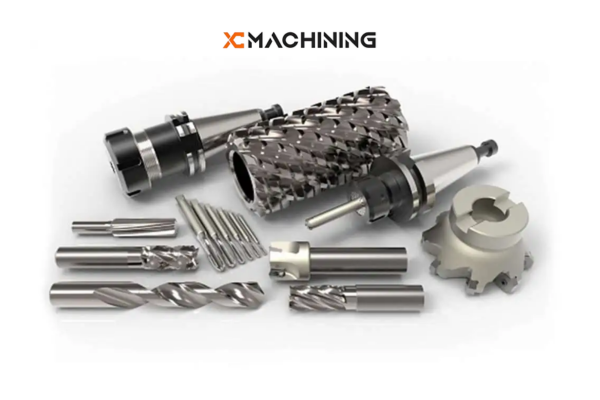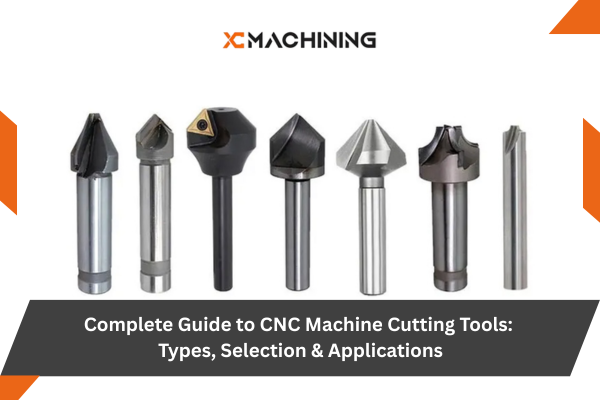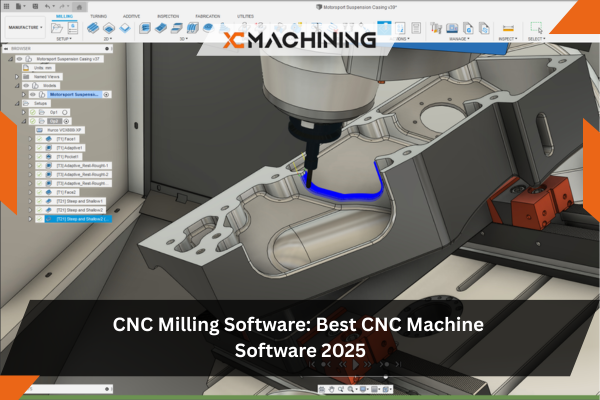Einführung
Getting the right cutting tool for a CNC-Maschine isn’t just about picking what’s in stock. After working with hundreds of machined parts across aerospace and medical projects, one thing becomes clear: tool selection directly impacts part quality, production speed, and profitability.
Die cnc machine cutting tools industry reached $98.32 billion in 2024, with projections showing continued growth through 2029. This expansion reflects manufacturing’s shift toward precision automation and the critical role of CNC machine cutting tools in achieving tight tolerances.
XC Machining has processed over 45,000 precision components since establishment, working with materials from aluminum to titanium. This guide shares practical knowledge gained from real machine shop operations.
Understanding CNC Tool Fundamentals
What Makes CNC Machine Tooling Different
A cnc tool differs fundamentally from hand tools. While manual cutting relies on operator skill and physical force, CNC systems use programmed paths and high spindle speeds. The Werkstück stays stationary while the rotating Kutter follows computer-controlled movements.
Flute design matters more than most realize. These helical grooves serve dual purposes—they create sharp cutting edges and provide channels for chip evacuation. Too few flutes in hard materials causes poor surface finish. Too many in soft materials leads to chip packing and tool breakage.
Tool life depends on three factors: base material, surface coating, and operating parameters. A $150 carbide Schaftfräser running at correct speeds might machine 1,200 parts. The same tool pushed 20% too fast fails after 300 parts. Simple math shows the economic impact.
Materials Used in Cutting Tools
High-speed steel remains popular for prototypes and small runs. The steel tools cost less upfront but wear faster. Carbide tools dominate production environments. The carbide cutting tools maintain sharp cutting edges at temperatures exceeding 900°C.
Ceramic cutters handle superalloys and cast iron effectively. Diamond-coated varieties excel with abrasive composites. Each material serves specific applications.
Werkzeugbeschichtungen extend service intervals significantly. TiN adds hardness. TiAlN handles high temperatures. AlCrN resists corrosion when machining stainless steel. Real-world testing at XC Machining shows coated tools lasting 300-400% longer than uncoated versions in steel applications.
Types of Tools Used in CNC Machines
Modern machine shops stock dozens of different cutting tools, each designed for specific operations. Understanding what each tool does and when to use it prevents costly mistakes and improves machining efficiency. The following tools represent the core inventory that handles 95% of typical CNC machining work.
End Mills: The Primary CNC Milling Tools
End mills represent the most versatile CNC machine cutting tools. These cnc milling tools feature cutting edges on both the end and sides, enabling various milling operations.
Standard end mills handle general work. Roughing end mills with serrated edges remove bulk material fast—important when working with large aluminum blocks. Ball nose end mills machine complex 3D contours. Each type serves distinct purposes.
A recent aerospace bracket project demonstrated this. Initial roughing with a 4-flute carbide removed 85% of material in 12 minutes. Switching to a ball Schaftfräser for contoured pockets added another 8 minutes. Using a single tool for both operations would have taken 35+ minutes with poor results.
Flute count matters. Two flutes work well for aluminum, providing large chip channels. Four to six flutes suit steel, offering better Oberflächengüte. Going beyond eight flutes rarely helps unless doing extremely light finishing cuts.

Drill Bits: Essential Hole Drilling Tools
CNC machining drill bits create cylindrical holes with precision. The twist drill remains most common, available in diameters from 0.5mm to 50mm. The helical grooves along the body evacuate chips efficiently.
Different drilling scenarios need different tools:
Center drills create starting points. These short, rigid tools prevent the main drill from wandering. Always use them before drilling holes over 10mm diameter.
Spot drills make shallow indentations that guide subsequent drilling. Critical when hole location tolerance matters—like mounting holes in medical device housings.
Deep hole drilling requires specialized tooling. Standard drill bits work for depths up to 5x diameter. Beyond that, chip evacuation becomes problematic. Peck drilling helps but slows production.
One medical client needed 40mm deep holes in titanium for spinal implants. Standard jobber drills couldn’t handle it. Switching to specialized deep-hole tooling with through-coolant delivery solved the problem, though feed rate dropped by 60%.
Face Mills: Efficient Surface Machining
A face mill creates flat surfaces quickly. The body with replaceable cutting inserts makes these tools made economical for production. When an insert dulls, swap it out. No need to replace the entire tool body.
Face mill diameters range from 25mm to 400mm. Larger diameters cover more area per pass but require more spindle power. For cnc-Fräsmaschine applications on engine blocks or transmission housings, face mills are the go-to tool.
XC Machining machines aluminum enclosures for electronics manufacturers. Using a 63mm face mill, surface preparation takes 3 minutes per part. Previous methods with end mills required 11 minutes. Simple choice for volume work.
Die cutting inserts come in various geometries. Positive rake angles reduce cutting forces but weaken the edge. Negative rake provides strength for interrupted cuts but needs more spindle power.
Thread Mills: Internal Thread Precision
Thread mill tools cut threads by following helical paths. Unlike taps, a single cutting tool handles multiple thread sizes. M6, M8, and M10 threads? One thread mill does all three.
These tools shine when machining hard materials. Tapping titanium or Inconel risks tap breakage. Thread mills handle it without issue. They also work in partial threads or interrupted holes where taps fail.
Recent work on aerospace fittings required M12x1.5 threads in 7075 aluminum. Using taps would be faster but risks cross-threading in this critical application. Thread milling added 45 seconds per hole but eliminated rejection risk. For aerospace work, that trade-off makes sense.
Reamers: Achieving Tight Tolerances
Reamers finish drilled holes to precise dimensions. They remove material in small amounts—typically 0.1 to 0.5mm. The tool features multiple straight or helical flutes that smooth the hole wall.
Hole drilling followed by reaming achieves tolerances of ±0.005mm. Medical implant manufacturing depends on this. Hip replacement components need bearing surfaces within microns. Drilling alone can’t deliver that.
Three reamer types handle different needs. Straight flute works for general applications. Helical flute reduces chatter in deep holes. Taper reamers create precise angles for pins and fittings.
Operating parameters matter. Run reamers at 50-70% of drilling speeds. Going faster generates heat that expands the workpiece material and ruins accuracy.
Specialty Cutting Tools for Unique Tasks
Fliegenschneider tools offer budget-friendly surfacing. A single carbide insert on a long arm creates broad, shallow cuts. Surface quality rivals face mills at 70% lower cost. Perfect for prototype shops.
Milling cutters for T-slots create mounting grooves in fixtures. Dovetail cutters machine angled undercuts for mechanical locks. Chamfer tools deburr edges and create countersinks for fasteners.
Each specialty tool solves specific problems. Stocking everything isn’t practical, but knowing what’s available prevents inefficient workarounds.
Selecting the Right CNC Milling Tools for Your Application
Choosing the wrong tool wastes time and money. Three primary factors determine optimal tool selection: workpiece material properties, specific machining operation requirements, and production volume expectations. Getting these decisions right from the start prevents do-overs and scrapped parts.
Material Considerations Drive Tool Choice
Workpiece material determines everything. Aluminum machines fast with 2-3 flute Hartmetallwerkzeuge and minimal coolant. Steel needs 4+ flutes, appropriate coatings, and flood coolant. Titanium requires conservative speeds and rigid setups to prevent work hardening.
Cutting tools made of carbon steel work for soft materials but lack heat resistance. High-speed steel handles moderate applications. Hartmetall dominates production—it costs more initially but the tool performance justifies it.
| Material Category | Recommended Tool | Flute Count | Beschichtung |
| Aluminum alloys | Uncoated carbide | 2-3 | Optional |
| Baustahl | Carbide with TiAlN | 4-6 | Ja |
| Rostfreier Stahl | Carbide with AlCrN | 4-6 | Ja |
| Titanium alloys | Carbide or ceramic | 4-5 | Ja |
| Kunststoffe | Polished carbide | 1-2 | Nein |
Composite materials need made of carbide or diamond-coated tools. Carbon fiber dulls standard tooling in minutes. Diamond coatings cost 4x more but last 15-20x longer. Calculate cost per part, not cost per tool.
Matching Tool Type to Machining Operation
Milling operations vary widely. Roughing removes bulk material. Finishing creates final surfaces. Contouring follows complex shapes. Each operation needs appropriate tooling.
For roughing, prioritize material removal rate. Roughing end mills with interrupted flutes handle heavy cuts. They produce larger chips that evacuate easily, preventing heat buildup.
Finishing requires sharp cutting edges and proper flute count. Four to six flutes balance cutting speed with surface quality. Going to eight flutes helps in some hard materials but risks chip packing.
3D profiling needs ball or bull nose end mills. The radiused tip follows curves without leaving step marks. The choice of material—aluminum part versus titanium—determines which specific tool from this category.
Production Volume Economics
Low volume work tolerates less expensive tooling. High-speed steel might suffice for 10-50 parts. The lower initial cost makes sense when tool wear isn’t critical.
Medium production runs (500-5,000 parts) justify premium carbide tooling. These tools are made to tighter tolerances with better coatings. Initial cost runs 3-4x higher but longevity more than compensates.
High-volume manufacturing demands the best available. A $300 end mill machining 5,000 parts costs $0.06 per part. A $75 tool lasting 800 parts costs $0.09 per part. Scale that across thousands of tool changes and savings become substantial.
Machine Tool Capabilities Matter
CNC-Maschine specifications limit tool choices. Spindle speed, power, and rigidity determine what works.
High-speed spindles (15,000+ RPM) need balanced tooling. Unbalanced tools cause vibration that ruins Oberflächengüte and accelerates tool wear. Shops running high-speed machining operation should invest in premium balanced tooling.
Through-spindle coolant extends tool life dramatically in steel and titanium. If the machine tool lacks this feature, external flood coolant helps but doesn’t match through-spindle performance.
Spindle taper type—CAT, BT, HSK—must match tool holders. Trying to use CAT40 tools in a BT40 spindle doesn’t work. Seems obvious but it’s a common mistake in shops with multiple machines.
Common CNC Tool Selection Mistakes
Even experienced machinists make tool selection errors that reduce efficiency and increase costs. Recognizing these common mistakes helps avoid them. The following issues appear repeatedly across different machine shops and skill levels.
Running Wrong Cutting Speed
Cutting speed impacts everything. Too slow causes built-up edge where workpiece material welds to the tool. Too fast generates excessive heat that dulls edges rapidly.
Calculating proper RPM requires knowing CNC machine cutting tools diameter and recommended surface speed. The formula: RPM = (Surface Speed × 1000) / (π × Diameter). Most tool materials come with manufacturer recommendations.
Real example: A 12mm carbide Schaftfräser in 6061 aluminum. Recommended surface speed: 400 m/min. Calculation: (400 × 1000) / (3.14 × 12) = 10,610 RPM. Running at 6,000 RPM risks built-up edge. Running at 15,000 RPM shortens tool life.
Inadequate Coolant Application
Heat kills tools. Period. Insufficient coolant reduces tool life by 60-70% in steel applications. The coolant must reach the cutting edges where heat generates.
Flood coolant directed at the cut zone works for most applications. Mist cooling suffices for aluminum. Through-spindle delivery reaches the cut better than external streams, especially in deep pockets.
Some materials don’t want coolant. Magnesium needs compressed air—coolant risks fire. Cast iron machines dry or with air blast. Plastics need cooling to prevent melting but too much pressure can crack brittle materials.

Ignoring Tool Wear Indicators
Tool wear progresses predictably. Watching for early signs prevents scrap parts and broken tools.
Listen for changes in cutting noise. A sharp tool cuts quietly. Dull tools make grinding sounds. Increased chatter indicates problems.
Watch Oberflächengüte quality. Degrading finishes despite correct parameters signal tool dulling. Cutting edges wear gradually—catching it early saves parts.
Check spindle load if your CNC-Maschine displays it. Rising load with constant parameters means the tool dulls. Some advanced machines automatically reduce feed rate when detecting excessive load.
Poor Tool Storage and Handling
Carbide cutting tools have extremely hard but brittle edges. Dropping them or storing them loose in drawers chips the edges. Those microscopic chips become major problems when cutting.
Use protective sleeves or foam-lined drawers. Organize by size and type. A tool crib system prevents “Where’s that 8mm end mill?” searches.
Clean tools before storage. Dried cutting fluid residue acts like sandpaper on adjacent tools. A quick wipe with solvent takes 10 seconds and prevents damage.
Industry Applications: Real-World Tool Usage
Different industries have unique machining requirements that influence tool selection. Understanding how automotive, aerospace, and medical sectors approach tooling provides practical insights. These real-world examples show how theory translates to actual production environments.
Automotive Manufacturing Demands
Automotive production consumes the largest share of cnc machine cutting tools capacity globally. Engine blocks, transmission housings, and suspension components all require precision machining.
XC Machining produces aluminum brackets for EV battery mounting systems. Each part needs:
- Face milling for datum surfaces (4-minute cycle)
- Drilling 12 mounting holes (3-minute cycle)
- Reaming 4 precision holes to ±0.01mm (2-minute cycle)
- Thread milling M8 threads (3-minute cycle)
Total cycle time: 12 minutes using appropriate tools used for each operation. Attempting everything with end mills alone would exceed 25 minutes.
Machined parts in automotive face cost pressure. Optimizing tool type selection and best cutting tools for cnc machining used directly impacts per-part economics. A 15% cycle time reduction across 50,000 annual parts creates significant value.
Aerospace Component Complexity
Aerospace machining requires extraordinary precision. Tolerances routinely reach ±0.025mm. Oberflächengüte specs demand Ra values below 0.8. Materials include titanium, Inconel, and aluminum alloys.
Recent work on aircraft structural brackets involved 7075-T6 aluminum. The types of CNC machine cutting tools included:
- 16mm roughing Schaftfräser for bulk removal
- 12mm ball nose for contoured pockets
- 6.35mm end mill for slot milling
- Various drill bits for hole patterns
- Countersink tools for fastener seats
Each tool serves a specific purpose. Using wrong tooling either fails to meet specifications or wastes time. Aerospace doesn’t tolerate either outcome.
Medical Device Precision Standards
Medical implants demand even tighter tolerances than aerospace. Hip replacements need bearing surfaces within microns. Dental implants require specific surface textures. Surgical instruments need mirror finishes.
Working with titanium Ti-6Al-4V presents challenges. The material work-hardens during machining. Conservative cutting speed und feed rate parameters prevent this. Carbide tools with appropriate coatings help. Through-coolant delivery is essential.
A recent femoral component project required:
- Rough machining with tools made for titanium (TiAlN coated)
- Finish machining for dimensional accuracy
- Polishing operations for surface texture
- Inspection confirming ±0.005mm tolerance
Total machining operation time: 45 minutes per component. Attempting shortcuts compromises quality. Medical applications don’t permit that.
Tool Maintenance Extends Performance
Proper maintenance significantly extends cutting tool lifespan and maintains part quality. Simple daily practices prevent most common tool failures. Implementing systematic maintenance routines pays for itself through reduced tool replacement costs and fewer rejected parts.
Daily Inspection Prevents Problems
Visual inspection catches issues early. Look for:
- Edge chipping or wear
- Coating damage
- Buildup on cutting edges
- Shank damage affecting tool holder grip
Clean tool shanks before every use. A dirty taper causes runout that ruins Oberflächengüte and accelerates wear. Takes 15 seconds with a shop rag and solvent.
Verify tool length offsets after tool changes. Even small errors cause incorrect Z-height positioning. Crashed tools cost more than the 30 seconds needed to touch off properly.
Proper Storage Protects Investment
Tools made from carbide need protective storage. Individual sleeves prevent edge contact. Foam-lined drawers work well. Tool cabinets organize by size and type.
Climate control matters more than expected. Humidity causes rust on steel shanks. Rust transfers to tool holders and spindle tapers, creating runout problems. A dehumidifier in the tool room prevents this.
Inventory tracking seems tedious but pays off. Knowing tool quantities prevents emergency ordering. Recording tool life helps predict replacement timing. Simple spreadsheet works fine—doesn’t need expensive software.
When to Recondition vs. Replace
Many carbide cutting tools can be professionally reground. Cost runs 30-50% of new tool price. A $200 Schaftfräser regrinds for $70-80. If it regrinds three times, effective cost drops to $110 per new tool equivalent.
Not all tools are worth regrinding. Small diameter end mills (under 6mm) cost more to regrind than replace. Complex geometries like thread mills rarely regrind well. Standard end mills and face mill bodies are ideal candidates.
Send tools for regrinding before they’re completely worn. Badly damaged tools can’t be restored effectively. When edges show noticeable wear but still have 70%+ diameter remaining, that’s the sweet spot.
Future Developments in CNC Machine Tooling
Technology continues advancing at a rapid pace in cutting tool development. Emerging innovations promise significant performance improvements over current offerings. Staying informed about these trends helps shops plan equipment investments strategically.
Smart Tools and Sensors
Embedded sensors in cutting tools represent emerging technology. These measure:
- Temperature at cutting edges
- Vibration indicating tool condition
- Cutting force changes
- Real-time wear progression
Data feeds into machine controllers for automatic parameter adjustment. When sensors detect excessive heat, the system reduces feed rate automatically. When vibration increases, it triggers tool change alerts.
Current implementations remain expensive—$800-1,500 per tool vs. $150 for standard tooling. As production scales up, prices will drop. Within 5 years, sensor tools may become standard in production environments.
Advanced Coating Technologies
Next-generation tool coatings promise significant improvements. Multi-layer coatings combine different materials for enhanced properties. Experimental graphene coatings show self-lubricating characteristics.
Current TiAlN coatings handle temperatures to 900°C. New aluminum chromium-based coatings push this to 1,100°C. Higher temperature resistance enables faster cutting speed and longer tool life.
Nanostructured coatings create extremely smooth surfaces that reduce friction. Initial testing shows 40-50% improvements in aluminum machining speeds. Commercial availability expected by 2026.
Hybrid Manufacturing Integration
Combining additive and subtractive processes changes tooling requirements. Parts start with 3D printing for complex internal geometries. CNC machining creates precision surfaces where needed.
This approach requires different types of cnc cutting tools used than traditional subtractive-only methods. Cutting printed metals presents unique challenges. The microstructure differs from wrought materials. Tool paths must account for varying material properties within a single Werkstück.
Several aerospace manufacturers already use hybrid processes for titanium components. Tools used in CNC machines need optimization for these applications. Expect continued development in this area.
Schlussfolgerung
Selecting appropriate cutting tools determines machining success. Understanding the types of cutting tools, matching tool materials to workpiece properties, and implementing proper maintenance practices maximize productivity and part quality.
Die cnc milling cutting tools industry continues evolving with new materials, coatings, and smart technologies. Staying informed about developments while maintaining fundamentals provides competitive advantage in precision manufacturing.
Häufig gestellte Fragen
What are the most essential types of tools used in CNC machines?
End mills, drill bits, and face mills handle the majority of operations. Add reamers for precision holes and thread mills for threaded features. These five tool types cover 90% of typical machine shop requirements.
How do carbide tools compare to high-speed steel options?
Carbide costs 3-4x more initially but lasts 5-10x longer with better heat resistance. For production runs, carbide delivers lower per-part cost despite higher purchase price. HSS remains economical for prototype work and soft materials.
When should cutting tools be replaced?
Replace when surface finish degrades, cutting noise increases, or visible wear appears. For critical parts, change tools at 80% of expected life. Track part count and establish scheduled replacement intervals based on actual performance data.
Which tool coating works best for steel machining operations?
TiAlN (titanium aluminum nitride) performs exceptionally well in steel applications. It handles high temperatures and extends tool life 300-400% compared to uncoated carbide. For stainless steel, consider AlCrN coatings that add corrosion resistance.
What causes premature CNC tool failure?
Incorrect cutting speeds account for 40% of failures. Inadequate coolant causes another 30%. Running worn tools beyond service life adds 20%. The remaining 10% comes from setup issues like insufficient rigidity or tool holder problems.
References
- Custom Market Insights. (2025). CNC Metal Cutting Machine Tools Market: Size, Share, and Trends Analysis Report 2025-2034.
- Technavio. (2025). Global CNC Machine Tools Market 2025-2029: Growth Analysis and Market Forecast.
- Fortune Business Insights. (2025). CNC Machine Market: Research and Industry Analysis Report 2024-2032.
- SNS Insider. (2025). CNC Machine Tools Market Size, Share, and Growth Forecast Analysis 2025-2032.
- Grand View Research. (2025). Machine Tools Market: Size, Share & Trends Analysis Report Through 2030.





